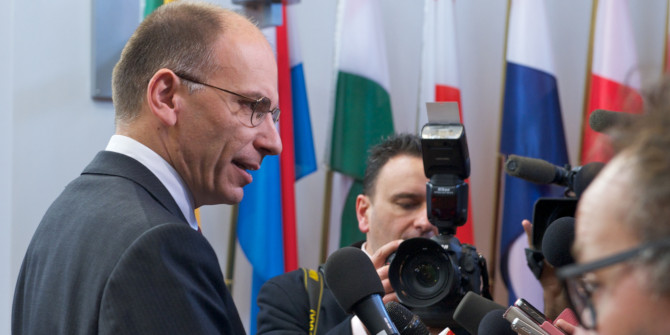Enrico Letta has been elected as the new leader of the Italian Democratic Party, with almost unanimous approval at the party’s national assembly. But do party leaders that win large victories in leadership elections last longer than those who win close contests? Drawing on a new study, Giulia Vicentini and Andrea Pritoni identify how five key conditions present in leadership contests can be used to assess the likely fate of party leaders.
The centre-left Italian Democratic Party (PD) has just appointed its eight leader since its foundation in 2007, following the unexpected and contentious resignation of Nicola Zingaretti, elected barely two years ago with 66 per cent of the vote in an open primary.
With the exception of a 15-month period between 2018 and 2019, the PD has effectively been in government as a junior or leading coalition partner for around a decade. Yet this did not prevent the party from returning to its congenital factionalism. As Zingaretti announced his resignation, he declared that he was “ashamed” of the party. This raises the question of whether the new party leader, former Prime Minister Enrico Letta, stands much chance of holding onto his position longer than his predecessors.
Political science offers no clear answer to this question. In recent years, following a growing trend toward the use of party primaries and one-member-one-vote systems in candidate and leader selection, there has been increased academic attention paid to the methods through which parties choose their leaders. However, there have been considerably fewer studies focused on how and why leadership tenures end.
The rise and fall of party leaders
In a recent study, we tried to assess whether these two separate moments – the rise and fall of a party leader – may be connected. To do so, we looked at leadership races in four western European countries (France, Germany, Italy and Spain) over the last three decades. We identified five key conditions present in leadership races that are likely to affect the future prospects of a party leader. These conditions can be expected to play a role both in isolation and in combination with one another.
The first condition is related to incumbency, namely whether the winning candidate is running for reelection as party leader. Second, there is the level of inclusiveness, both in terms of the number of candidates running and the number of people allowed to participate in the selection process. Third, there is the scale of victory secured by the winning candidate, as well as the party’s participation in government during the tenure of the leadership. Finally, the size of the party’s electoral support can be expected to have an impact, with a division apparent between large ‘mainstream’ parties and smaller ‘niche’ or ‘challenger’ parties.

Enrico Letta while serving as Italian Prime Minister in 2013, Credit: European Council
Using data from 172 leadership races, including reappointments at the end of a term, we were able to identify four different combinations of conditions that are likely to favour the reelection of a leader and which imply a forced (early) departure is less likely. The first, which is in line with theoretical expectations, is that incumbency is a key advantage. This is expected given existing leaders who run for a new term have the capacity to exert a high level of control over internal party dynamics and generally have greater resources at their disposal to help them maintain power.
Second, candidates elected as leaders of parties that are absent from government and have limited electoral support are more likely to retain their position as leader over time. This is also in line with theoretical expectations. Small niche and challenger parties often have different goals from larger parties. Previous research has shown that these parties frequently suffer from government participation.
Third, there is a positive effect for those candidates that secure a large victory to lead a party that is not in government. Most leadership contests that presented these two conditions in our study were the first and second appointments of long-standing leaders. The fact that such candidates won large victories in leadership contests suggests that from the very beginning the party establishment and/or grassroots members detected ‘leadership skills’ in these candidates.
Finally, leaders appointed via inclusive selection processes by parties that have limited electoral support also have a higher chance of winning reelection. However, this combination of conditions only accounted for a few atypical cases in our study, which were generally leaders of mainstream parties facing a loss of electoral support. In fact, the adoption of inclusive selection procedures is more likely in moments of crisis, given they are expected to legitimise the party leader in the eyes of the public.
Assessing Letta’s chances
Overall, our empirical analysis demonstrates the importance of focusing on combinations of conditions, but it also suggests we should be cautious about making generalised inferences. With this stated, what can our findings tell us about Enrico Letta’s prospects as the new leader of the Democratic Party?
First, our research suggests that government participation is no guarantee that a party leader will hold onto their position. Second, the link between the rise and fall of party leaders is far from straightforward. On the one hand, the assumed legitimisation that may arise from an inclusive selection process and a large victory in a leadership contest does not guarantee a stronger position for the new leader once they take over, as testified by Zingaretti’s recent resignation. On the other hand, close leadership contests and less inclusive processes are not necessarily destructive for party cohesion or harmful for a party leader’s long-term prospects either.
The fact that Letta was the only candidate and that he received 99 per cent consent from a small ‘selectorate’ therefore offers little guarantee of his survival as leader. Letta’s election as leader has similarities with the previous appointments of Dario Franceschini and Maurizio Martina. Both Franceschini and Martina were uncontested candidates for the PD leadership who were elected with a high level of consent following the resignation of the previous party leader. Following their election, they both lost a subsequent primary.
Indeed, large victories of the kind won by Letta often simply reflect a lack of valid alternative candidates and the need to show unity at a delicate moment. Perhaps only the most optimistic of PD supporters would suggest that Letta’s comeback, after a six-year retirement from active politics following Matteo Renzi’s decision to oust him from the Italian Premiership, has magically solved the factional conflicts that lie at the heart of the party.
For more information, see the authors’ accompanying paper in the Italian Political Science Review
Note: This article gives the views of the authors, not the position of EUROPP – European Politics and Policy or the London School of Economics. Featured image credit: European Council





